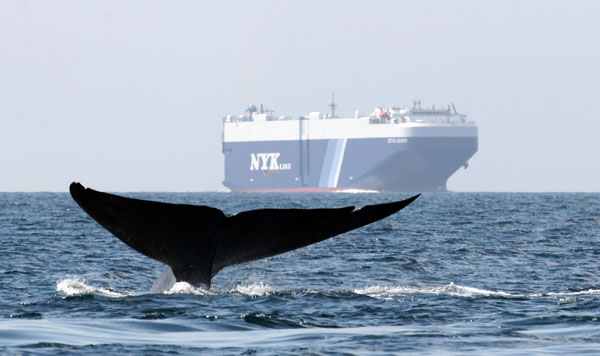Taking it Slow
By Kathryn Klett
Six shipping companies agree to slow down in Santa Barbara Channel to reduce pollution, protect endangered whales.
If you listen closely, you might hear the sound of whales singing in the Santa Barbara Channel. And with good reason – the fast pace of the Channel’s shipping lanes is slowing down a bit, as ships from six companies curb their speed in an effort to reduce air pollution and avoid striking the whales.
Government, non-profit, and marine industry groups are working together in a new trial incentive program that will slow down ships travelling from Point Conception to the Ports of Los Angeles and Long Beach. Companies will be paid to reduce the speed of selected vessels in their fleets to 12 knots or less, down from the usual 14-18 knots at which ships normally travel through the channel. That’s about the same as slowing the ships down from 20 miles per hour to less than 13 miles per hour, and it can mean the difference between life and death for the whales that feed in the Santa Barbara Channel.
The trial program is modeled after similar efforts at the Ports of Long Beach and Los Angeles that have proven to be successful, with 90 percent of shipping companies eventually participating. Six global shipping companies, COSCO, Hapag Lloyd, K Line, Maersk Line, Matson, and United Arab Shipping Company are participating in the speed reduction incentive program from July through October. Each company will receive $2,500 per vessel that passes through the Santa Barbara Channel. The program was developed and implemented by the Santa Barbara County Air Pollution Control District, NOAA’s Channel Islands National Marine Sanctuary and the Environmental Defense Center.
Ship strikes are a major threat to the endangered baleen whales that gather to feed on krill, their main food source, in shipping lanes. One of the program’s main goals is to encourage the ongoing recovery of whale populations in places like the Santa Barbara Channel.
“Slowing ships down reduces the likelihood that a ship strike on a whale will be fatal,” said Chris Mobley, superintendent, Channel Islands National Marine Sanctuary.
Kristi Birney, of the Environmental Defense Center, agrees.
“Few people realize that ships off our coast, especially those moving at faster speeds, are a risk to endangered whales and the quality of the air we breathe,” Birney said.
It’s true about the air quality – ships release greenhouse gases and air pollutants into the atmosphere, and account for more than 50 percent of ozone-forming nitrogen oxides in Santa Barbara County, according to county air pollution research.
“Reducing ship speeds to 12 knots or less reduces emissions of smog-forming air pollutants that harm our health,” said Dave Van Millem, director, Santa Barbara County Air pollution Control district. “We are pleased to be part of this partnership to achieve common goals, and excited about the potential for improving air quality in our county.”
So far, shipping industry response has been positive, with the coalition receiving more than 25 requests for ship transits to be included in the trial. At the moment the program can only fund 16 transits, but members are seeking additional funding to expand the trial. Current funds are provided by local and national foundations, including the National Marine Sanctuary Foundation. | 
 Photo: John Calambokidis, Cascadia Research
Photo: John Calambokidis, Cascadia Research

 Photo: John Calambokidis, Cascadia Research
Photo: John Calambokidis, Cascadia Research